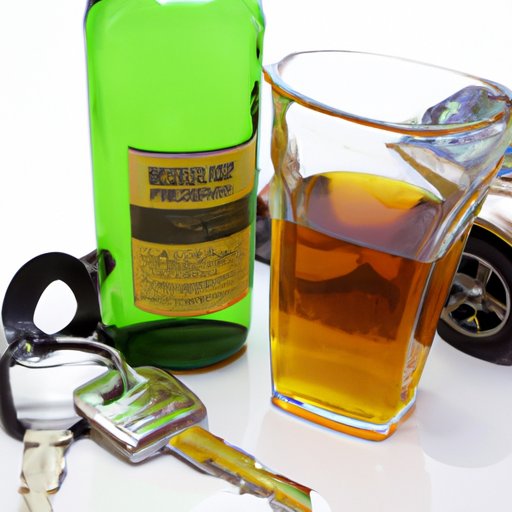Introduction
Driving after drinking alcohol is a serious issue that has been around since the invention of motorized vehicles. Knowing when it is safe to get behind the wheel after drinking can be difficult to determine. This article will explore the legal and safety implications of driving after consuming alcohol.
Exploring the Legal and Safety Implications of Driving After Drinking Alcohol
Understanding Blood Alcohol Concentration (BAC) Limits: In the United States, the legal limit for BAC is 0.08% or lower. Any higher than that, and you can be charged with driving under the influence (DUI). However, some states have adopted a zero-tolerance policy for drivers under 21, meaning any amount of alcohol in their system is grounds for a DUI charge.
Examining State Laws on Driving Under the Influence (DUI): All states have laws against driving under the influence of alcohol. Depending on the state, there may be different punishments for a DUI conviction. These can range from fines and license suspension to jail time. Additionally, many states have “per se” laws that make it illegal to drive with a BAC over the legal limit, regardless of whether or not the driver is impaired.

Examining the Effects of Alcohol on Driving Performance
Impairment of Motor Skills: Alcohol consumption can affect motor skills such as coordination, balance, and reaction time. As a result, driving under the influence can lead to slower reaction times, difficulty staying in the correct lane, and an increased risk of accidents.
Slowed Reaction Time: Alcohol slows down the body’s response time, making it harder to react quickly to unexpected events. This can be especially dangerous when driving, as it can increase the risk of an accident.
Loss of Judgment: Alcohol can impair judgment, making it difficult to make sound decisions while driving. Impaired judgment can lead to risky behavior such as speeding or aggressive driving, which can increase the risk of an accident.

Understanding How Long it Takes for Alcohol to Leave Your System
Factors Affecting Metabolism of Alcohol: There are several factors that can affect how quickly alcohol leaves your system. These include age, gender, weight, and how much alcohol was consumed. Generally speaking, younger people tend to metabolize alcohol faster than older people.
Estimating Time Required for Alcohol to be Processed by Body: Generally speaking, it takes about one hour for your body to process one standard drink. So if you had four drinks, it would take approximately four hours for all of the alcohol to leave your system. However, this is just an estimate, and it can vary depending on the individual.

Investigating the Risks of Driving After Drinking Alcohol
Potential Penalties for DUI: Driving under the influence of alcohol can lead to serious consequences. Depending on the state, you could face jail time, fines, license suspension, and other penalties. Additionally, a DUI conviction could stay on your record for years, affecting your ability to get jobs, loans, and housing.
Increased Risk of Vehicular Accidents: Driving after consuming alcohol increases the risk of being involved in an accident. Even if you don’t feel impaired, your reaction time and judgment can still be affected by alcohol, making it more difficult to avoid a crash.
Comparing Different Blood Alcohol Concentration Limits Across States
Variations in State BAC Limits: While the federal legal limit for BAC is 0.08%, some states have stricter limits. For example, California has a limit of 0.05%. Additionally, some states have different limits for commercial drivers, such as truck drivers.
Comparing Zero Tolerance and Per Se Laws: Some states have adopted zero tolerance laws for drivers under 21, meaning any amount of alcohol in their system is grounds for a DUI charge. Other states have per se laws, which make it illegal to drive with a BAC over the legal limit, regardless of whether or not the driver is impaired.
Conclusion
In conclusion, driving after drinking alcohol is a serious issue that can have legal and safety implications. It is important to understand the effects of alcohol on driving performance, as well as the potential penalties for a DUI conviction. Additionally, it is important to know how long it takes for alcohol to leave your system before getting behind the wheel. Ultimately, the safest choice is to not drive after consuming alcohol.
This article has explored the legal and safety implications of driving after consuming alcohol. It has examined blood alcohol concentration limits, state laws on driving under the influence, and how long it takes for alcohol to leave your system. The risks of driving after drinking alcohol were also discussed. By understanding these issues, you can make an informed decision about when it is safe to drive after consuming alcohol.
(Note: Is this article not meeting your expectations? Do you have knowledge or insights to share? Unlock new opportunities and expand your reach by joining our authors team. Click Registration to join us and share your expertise with our readers.)
